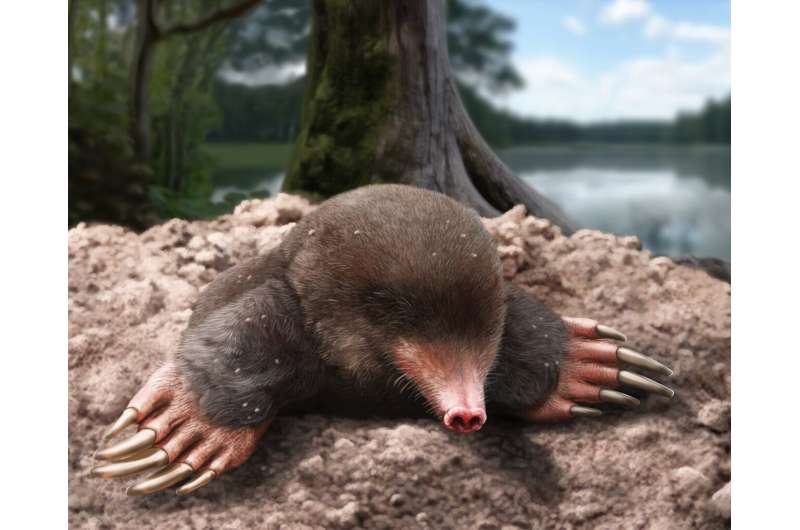Science
Researchers Uncover New Mole Species from Pliocene Fossil

A team of researchers has identified a new genus and species of mole, named Vulcanoscaptor ninoti, from a fossil discovered at the Camp dels Ninots site in Caldes de Malavella, Spain. This significant find sheds light on the evolutionary history of moles, revealing insights into their past distribution and anatomical diversity.
The fossil, unearthed at one of southern Europe’s most important paleontological sites, dates back over 3.5 million years to the Pliocene epoch. Researchers from the Institut Català de Paleoecologia Humana i Evolució Social (IPHES-CERCA), the Universitat Autònoma de Barcelona (UAB), and the Institut Català de Paleontologia Miquel Crusafont (ICP-CERCA) collaborated on this groundbreaking study, published in Scientific Reports.
The specimen maintains an impressive state of preservation, including the mandible with complete dentition, parts of the torso, and numerous bones from both forelimbs and hindlimbs. Many of these bones remain in anatomical connection, making this fossil one of the most complete and oldest moles ever found in Europe.
Unexpected Evolutionary Insights
Anatomical and phylogenetic analyses indicate that Vulcanoscaptor ninoti belongs to the Scalopini tribe, which is currently found only in North America and parts of Asia. This discovery suggests a more complex evolutionary scenario for moles than previously understood.
“Despite its clearly fossorial morphology, this mole is closely related to extant North American species of the genera Scapanus and Scalopus, which points to a far more intricate evolutionary history for these animals than we had imagined,” noted Dr. Marc Furió, a professor at UAB and co-author of the study. The presence of this mole in Europe indicates possible transcontinental migrations, challenging the notion that moles are limited in their dispersal capabilities.
The fossil, which was found embedded in compact sediment, was entirely extracted during excavation. To study it without causing damage, the research team employed high-resolution micro-computed tomography (microCT) scanning. This technique allowed them to create a detailed three-dimensional digital reconstruction of the skeleton.
“With the microCT, we were able to analyze extremely small and delicate structures—such as phalanges and teeth—that would have been nearly impossible to study otherwise,” explained Adriana Linares, the study’s lead author and a researcher at IPHES-CERCA. This innovative approach facilitated the identification of unique anatomical features, solidifying the placement of this new taxon within the Scalopini tribe.
Unique Geological Context
The Camp dels Ninots site, where the fossil was discovered in 2010, has been a focal point for paleontological research since 2003. Declared a Cultural Asset of National Interest by the Government of Catalonia in 2015, this location is situated within the crater of a Pliocene maar volcano. The sediments, deposited in anoxic conditions, have created an environment that preserves a rich fossil record.
The site is renowned for its diverse vertebrate remains, including large mammals, microfauna, birds, amphibians, reptiles, and fish, as well as macrovegetal remains and microorganisms. Notably, complete skeletons of large mammals such as Stephanorhinus jeanvireti and Tapirus arvernensis have been found in excellent anatomical condition.
“Camp dels Ninots is an extraordinary site, in terms of both the quality and diversity of its fossil record,” stated Dr. Gerard Campeny, co-director of the excavations and researcher at IPHES-CERCA. “It allows us to reconstruct entire ecosystems from this fascinating period: the Pliocene.”
The findings regarding Vulcanoscaptor ninoti contribute to a reassessment of the evolutionary history of moles, highlighting the potential for intercontinental dispersals and an underappreciated anatomical diversity among small mammals. This research emphasizes the significance of exceptional fossil sites in enhancing our understanding of species that are rarely represented in the fossil record.
For further details, refer to the study by Adriana Linares-Martín et al., titled “An unexpected Scalopini mole (Talpidae, Mammalia) from the Pliocene of Europe sheds light on the phylogeny of talpids,” published in Scientific Reports in 2025.
-

 World3 days ago
World3 days agoCoronation Street’s Shocking Murder Twist Reveals Family Secrets
-

 Entertainment4 months ago
Entertainment4 months agoKate Garraway Sells £2 Million Home Amid Financial Struggles
-

 Entertainment3 months ago
Entertainment3 months agoAnn Ming Reflects on ITV’s ‘I Fought the Law’ Drama
-

 Health3 months ago
Health3 months agoKatie Price Faces New Health Concerns After Cancer Symptoms Resurface
-

 Entertainment3 weeks ago
Entertainment3 weeks agoCoronation Street Fans React as Todd Faces Heartbreaking Choice
-

 World4 weeks ago
World4 weeks agoBailey Announces Heartbreaking Split from Rebecca After Reunion
-

 Entertainment6 days ago
Entertainment6 days agoTwo Stars Evicted from I’m A Celebrity Just Days Before Finale
-

 World6 days ago
World6 days agoKevin Sinfield Exceeds Fundraising Goal Ahead of Final Marathons
-

 Entertainment3 months ago
Entertainment3 months agoCoronation Street’s Carl Webster Faces Trouble with New Affairs
-

 Entertainment3 months ago
Entertainment3 months agoWhere is Tinder Swindler Simon Leviev? Latest Updates Revealed
-

 Entertainment4 months ago
Entertainment4 months agoMarkiplier Addresses AI Controversy During Livestream Response
-

 Science2 months ago
Science2 months agoBrian Cox Addresses Claims of Alien Probe in 3I/ATLAS Discovery



















